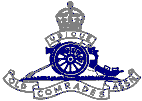36 (Arcot 1751) Battery RA
till 1993
36 Battery
was raised as the Madras Artillery on 17th June 1748, the honour title was granted in 1969
and commemorates the siege of that town by Clive in 1751.
Robert Clive realised that the capture of Arcot
the Capital of the Carnatic would prevent the French dominating Southern India With a small force of 200 Europeans 300 Sepoys
and 20 Madras Artillerymen Clive evicted the French and Native garrison and occupied the fort which was in a state of disrepair
As the fort was overlooked by the city now occupied by the former garrison it came under siege Clive set to work to repair
the fort and made three sorties into the town; on the third sortie the gunners withdrew their guns by using their recoil As
the siege progressed the important role of the gunners became clear; the enemy constructed a raised Battery by filling a house
with rammed earth and mounting their guns on the top; the Madras gunners waited until it was completed and after an hour s sustained bombardment
the Battery collapsed in the final enemy thrust Clive himself directed the fire of the guns After 50 days the siege was lifted
Following sustained service in India
the Madras artillery was amalgamated with the Royal Artillery in 1861
The Battery fought throughout the Great War
as a Heavy Battery and in the Second World War in France and Italy.
After the war it served in Palestine and Cyprus before moving to Sennelager with the Honest John Rocket in 1960. The Battery moved to Menden in
1972 and in 1975 re-equipped with the Lance missile
36 Battery had the distinction of being the first
British unit to fire both Honest John and Lance.
(Info.
from 50 Missile Regt RA Website)
6/36 (Arcot 1751) Battery RA
as 1993
6/36 (ARCOT) 1751 Battery was
formed in 1993 upon the amalgamation of 6 Battery and 36 (Arcot 1751) Battery. It is the senior Battery within the Regiment and can trace its beginnings to the War
of Austrian Succession in 1743. Its honour title ARCOT comes from the capture and defence of Arcot in 1751, an action that
was the major turning point for the British in India.
(Info. from 40 Regt RA Website)

